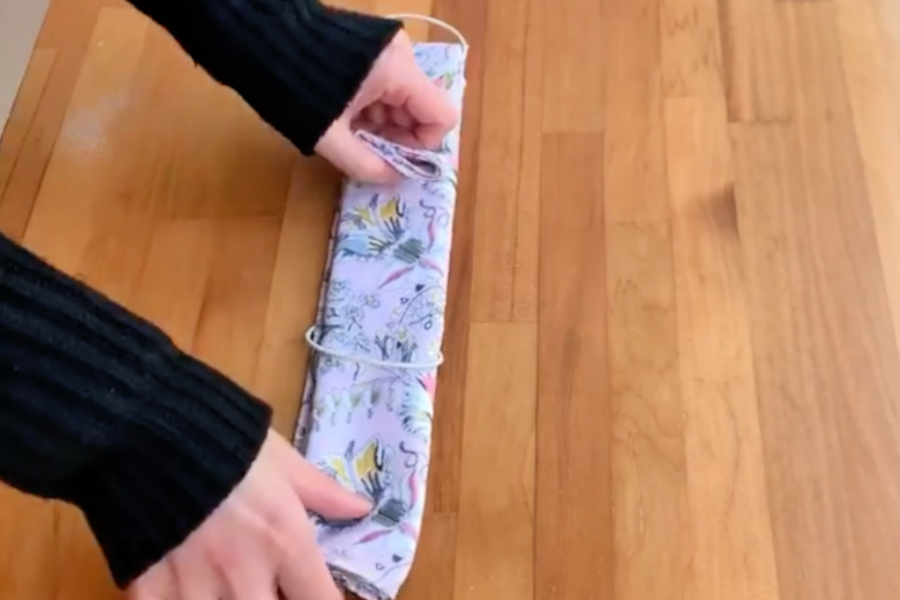I have spent the past week grappling with whether or not to make my own face mask and upgrade from the bandana I’ve been wearing over my mouth and nose when I head out for groceries. The thing is, I don’t sew.
This post last updated April 6 with new information, tips, and links about the efficacy of masks
Last night though, my decision was made. Because after much debate — though it still continues — the CDC now officially recommends that we all wear cloth masks out of the house during the COVID-19 pandemic. In part because as many of 25% of people infected with the novel Coronavirus don’t show symptoms. Wow.
Wearing a mask provides a little protection for you, but it’s more about helping to protect others; it’s also about destigmatizing mask-wearing in our country, so that anyone who’s sick or potentially sick with COVID-19 won’t feel embarrassed or uncomfortable to wear a mask.
This is about wearing basic, homemade cloth masks, by the way; not N95 masks. (See note below.)
So as a NYC resident who is heading into week four of social distancing, and someone missing the sewing gene — it evidently skips a generation in our family — I am thrilled that Lisa sent me this genius tutorial for making a new-sew face mask.
Related: 7 of our favorite meditation apps to help with anxiety right now. Deep breaths, everyone.

Our own Lisa modeling her masterpiece
It comes courtesy of Japanese handkerchief shop @intermode_Kawabe on Instagram, and yields a perfectly serviceable homemade facemark without requiring you to sew even a stitch.
Don’t worry, you don’t need to speak a word of Japanese to follow the video, though I’ve taken the liberty of putting it through Google translate for you and then adding some commentary.
Instructions for a new-sew mask:
View this post on Instagram
1. Start with a 50x50cm (about 19″ square) handkerchief. You can also adjust the fold size if you have a smaller or larger piece of fabric.
2. Fold the handkerchief in four — just fold in half, then in half again. The narrower the final fold, the better. (You can also fold in half, then fold the top and bottom into thirds, then in half again as in the other video from Kawabe.)
3. Slide a ponytail elastic (or rubber band) on each side, about a 2:3:2 ratio but it doesn’t have to be perfect.
4. Fold each end inward toward the center and overlapping a bit to complete. Tuck the excess fabric from one end into the other.
5. Hook the elastics onto your ears, then slide the fabric in the middle up over your nose and pull the bottom down over your chin to adjust to your own face. Done!
DIY Facemask tips and notes:
Last updated April 6
 Lisa’s sister, Kari Bacon, rocking her new-sew mask.
Lisa’s sister, Kari Bacon, rocking her new-sew mask.
– They suggest you make the width of the fabric slightly larger than the size of your face when folding — if the width is too small, the elastics will pull on your ears. (Hi, I looked like Baby New Year first time I tried it), and if it’s too wide it will fall off.
Tip: If you’re making one for someone with.a larger face, you can double the rubber bands on each side by looping one through the other to make a figure eight.
– If you don’t have a handkerchief, feel free to use a scrap of cotton fabric, or just cut up an old t-shirt. I find if the fabric is too stretchy though (like a Lycra-cotton blend) you’ll have trouble with it. Others are having good success with old cotton pillow cases.
– According to Farhad Manjoo’s NY Times editorial about making and wearing our own masks, as long as a your mask covers your nose and mouth comfortably, it’s okay to use whatever pattern you want. Since most of us are not working with vacuum cleaner bags here, he states that “plain cotton T-shirt fabric still provides a useful barrier.” Just make sure your mask is clean.

– The CDC recommends you can use a strip of coffee filter in the folds of a tutorial like ours for added protection — something we may be more likely to have at home than a vacuum bag. Just cut in half, and use the top portion. (You can reuse the bottom portion for a small, afternoon pour-over cup of coffee. Less waste!) Note that they suggest this for bandana masks specifically, because bandanas are thinner than other cotton fabrics. (While you’re at it, be sure any bandanas are folded 2-4 times.)
– Tip from readers: If you want the face mask to conform to your face above your nose, you can insert a flexible wire at the top, or Elan Morgan suggests you include a folded square of aluminum foil or even twist ties from bread in the top fold. Pipe cleaners work too.
– A twitter question from Amy Geise yields good advice about keeping glasses from fogging up with a mask.
– If you have a “cute” fabric, and it makes you (and your kid) more likely to wear it, then great. If you don’t, whatever. It’s a face mask.
– Masks are NOT an excuse to avoid social distancing. Do NOT put a mask on your kids then send them out to the playground with friends. Please. Please. I know we’re all going a little stir crazy, but like, let’s be responsible and end this thing sooner?
– I’m not going to get too far into all the do’s-and don’ts (like not touching your face, washing it, and so on) because there’s a lot of info out there already. Needless to say, don’t touch your face after picking up groceries, swiping your card, and all that fun stuff. Take it off when you get home, wash it, and wash your hands.
– When. you walk down the street wearing a mask, you may smile at neighbors (from 6-feet apart of course) and they will not be able to see that you’re smiling and that, for someone like me who smiles at everyone, is super weird. Wave to people instead. Even small social interactions go a long way.
– Do NOT wear an N95 mask if you’re not a medical professional or severely immunocompromised, or everyone will think you are a huge ass. Or worse. If you have some, it’s not too late to deliver them to your local hospital.
– Be kind. Wash your hands. (That’s not about masks. Just something I mention any chance I get.)
Still need to prove to skeptical friends, family, and contrarian social media randos that masks work? Show them these links.
Yeah yeah, we’re getting it on our social feeds too. And since “something is better than nothing” (also known as “don’t let perfection be the enemy of the good”) can mean a difference in hundreds of thousands of lives, here are a few trusted resources and links to share should you need them.
Just remember: A mask — homemade or otherwise — in no way reduces the need for staying at home as much as possible if you are able, and for social and physical distancing when you’re out of the home.
– The CDC officially recommends homemade face masks in public because, “as researchers have learned more about how the highly contagious virus spreads, officials have changed their recommendations.”
– Several cities and communities are strongly recommending face masks, like NYC and LA, all of Riverside County and San Diego County, CA; while Laredo, TX is the first city to mandate it with penalties. More will follow, guaranteed. So, get ahead of it and make a mask, folks!
– The link tiny.cc/maskswork was compiled by research scientist Jeremy Howard, and take you to a thoroughly compiled Google doc of all kinds of links to reputable research about the efficacy of masks.
TL;DR: They have found “34 scientific papers indicating basic masks can be effective in reducing virus transmission in public — and not a single paper that shows clear evidence that they cannot. Studies have documented definitively that in controlled environments like airplanes, people with masks rarely infect others and rarely become infected themselves, while those without masks more easily infect others or become infected themselves.”
– In his Washington Post op ed, Howard also describes how The WHO’s current anti-mask recommendations (for now) are not based on science, but on “spurious policy arguments.” (i.e. not enough masks for hospital workers.) It’s a really really good article.
– In a candid Science Magazine interview, the impressively credentialed (Ph.D. in biochemistry at the University of Oxford, postdocs at Oxford and Harvard) Director-General of the Chinese Center for Disease Control and Prevention states plainly: The big mistake in the U.S. and Europe, in my opinion, is that people aren’t wearing masks. This virus is transmitted by droplets and close contact. Droplets play a very important role—you’ve got to wear a mask, because when you speak, there are always droplets coming out of your mouth. Many people have asymptomatic or presymptomatic infections. If they are wearing face masks, it can prevent droplets that carry the virus from escaping and infecting others.

– NiH published research from the National Center for National Biotechnology Information (above) clearly conclude that for the general public, “any type of general mask use is likely to decrease viral exposure and infection risk on a population level, in spite of imperfect fit and imperfect adherence”
In other words, the “something is better than nothing argument is worthwhile when we’re talking about potential deaths in the hundreds of thousands.
– Talking to someone who doesn’t believe the “fake news liberal media?” All hope is not lost. Maybe they’ll respond best to this this thorough set of recommendations published in the conservative-leaning American Enterprise Institute that strongly suggests that to reduce risk and speed up recovery, all people should be encouraged to wear nonmusical fabric face masks while in public, and that the wider the use, the more they may help prevent people who are asymptomatically infected from transmitting the disease unknowingly.
Flatten the curve, slow the spread, reduce the risks NOW, and we can all get back to life sooner.



